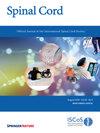脊髓损伤康复期间重要他人的心理筛查。
IF 2.2
4区 医学
Q3 CLINICAL NEUROLOGY
引用次数: 0
摘要
设计回顾性队列研究:确定重要他人(SOs)在脊髓损伤(SCI)初期康复过程中的负担和心理困扰,并根据SOs和SCI患者(PSCIs)在康复初期的特征预测出院时照顾者的负担:地点:荷兰奈梅亨 Sint Maartenskliniek 康复中心:方法:纳入 2020 年 10 月至 2022 年 12 月期间接受初次康复治疗的所有 SCI 患者。我们要求他们的一名护理人员完成一套筛查问卷,这些问卷是在我们的常规护理范围内收集的:共有181名PSCI患者(62%为男性,平均年龄60岁,80%为不完全性SCI,60%为截瘫,伤后32天)和158名SO(40%为男性,平均年龄57岁)在入院时接受了筛查,出院时分别有145人和93人接受了筛查。入院时,护理人员的平均负担以及抑郁和焦虑情绪没有变化。入院时的照顾者负担得分对出院时的照顾者负担得分的预测效果最好,占 20%(P 结论:入院时的照顾者负担得分对出院时的照顾者负担得分的预测效果最好,占 20%):这组 SO 患者在康复期间的照顾者负担高于慢性期的代表性群体。在这两项评估中,约有 20% 的人得分高于临界值。心理压力得分与之前的研究结果相当。在最初的 SCI 康复过程中对 SO 进行标准筛查非常重要,这有助于跨学科团队识别有风险的 SO,并在住院康复期间对其进行有针对性的治疗。本文章由计算机程序翻译,如有差异,请以英文原文为准。
Psychological screening of significant others during spinal cord injury rehabilitation
Retrospective cohort study. Determine the course of burden and psychological distress of significant others (SOs) during initial spinal cord injury (SCI) rehabilitation and to predict the caregiver’s burden at discharge with characteristics of SOs and persons with SCI (PSCIs) at the start of rehabilitation. Rehabilitation center Sint Maartenskliniek, Nijmegen, The Netherlands. All PSCIs admitted for initial rehabilitation between October 2020 and December 2022 were included. One of their SOs were asked to complete a set of screening questionnaires, collected in our routine context of care. A total of 181 PSCIs (62% male, average age 60 years, 80% incomplete SCI, 60% paraplegia and 32 days after injury) and 158 SOs (40% male, average age 57 years) were screened at admission, and 145 and 93 at discharge, respectively. For SOs, the average caregiver’s burden and feelings of depression and anxiety did not change during admission. The caregiver’s burden score at discharge was best predicted by the burden score at admission, explaining 20% (P < 0.001) of the variance. An additional 13% (P = 0.02) of the variance was explained by other SO and PSCI variables gathered in this study. The caregiver’s burden in this group of SOs during rehabilitation, was higher than that of a representative group in the chronic phase. On both assessments, around 20% scored above the cutoff. Scores of psychological distress are comparable to former studies. Standard screening of SOs during initial SCI rehabilitation is important to help the interdisciplinary team identify SOs at risk, and target their treatment during inpatient rehabilitation.
求助全文
通过发布文献求助,成功后即可免费获取论文全文。
去求助
来源期刊

Spinal cord
医学-临床神经学
CiteScore
4.50
自引率
9.10%
发文量
142
审稿时长
2 months
期刊介绍:
Spinal Cord is a specialised, international journal that has been publishing spinal cord related manuscripts since 1963. It appears monthly, online and in print, and accepts contributions on spinal cord anatomy, physiology, management of injury and disease, and the quality of life and life circumstances of people with a spinal cord injury. Spinal Cord is multi-disciplinary and publishes contributions across the entire spectrum of research ranging from basic science to applied clinical research. It focuses on high quality original research, systematic reviews and narrative reviews.
Spinal Cord''s sister journal Spinal Cord Series and Cases: Clinical Management in Spinal Cord Disorders publishes high quality case reports, small case series, pilot and retrospective studies perspectives, Pulse survey articles, Point-couterpoint articles, correspondences and book reviews. It specialises in material that addresses all aspects of life for persons with spinal cord injuries or disorders. For more information, please see the aims and scope of Spinal Cord Series and Cases.
 求助内容:
求助内容: 应助结果提醒方式:
应助结果提醒方式:


